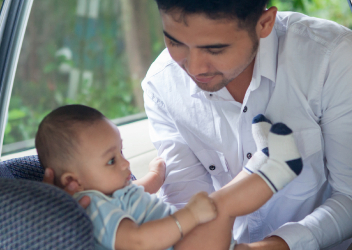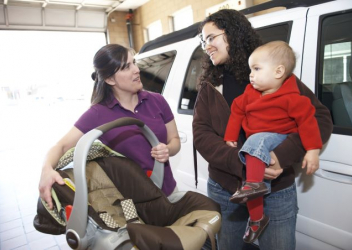Research In Action
Research In Action
Breadcrumb

This week, from September 17th to 23rd, is dedicated to observing Child Passenger Safety (CPS) Week. In 2021, 710 children under 13 were killed in passenger vehicles, and more than 100,000 were injured. More than a third (36%) of children under 13 who died while riding in passenger vehicles were unrestrained. Because motor vehicle crashes remain a leading cause of death for children in the US, it remains critical that families use the appropriate child safety seat or booster seat that's right for a child’s age and size.
Challenges with Unbuckling
In my developmental and behavioral pediatrics practice, parents often raise concerns about child passenger safety in the context of challenging behaviors associated with developmental disabilities. Oftentimes, the solution is not straightforward. For instance, for my patients with significant behavioral challenges associated with ADHD and/or autism spectrum disorders, families frequently report that their children unbuckle their seat belt or safety restraint while the car is moving. In addition to the risks these behaviors present to the child, these behaviors typically distract the driver as well, putting the family at risk for a crash.
I reached out to Jacquelyn Reid, an injury prevention coordinator at CHOP's Injury Prevention Program, for further guidance. She first recommends that families explore the potential factors creating unsafe driving experience. "It is important to understand the root cause and what educational methods may work for the child, such as positive reinforcement, logical reasoning, and informative visuals. Families should not try and make their own adaptions to car seats, as this could result in increased risk and endangerment. Clinicians should refer to a Child Passenger Safety Technician (CPST) to discuss safe adaptive options permitted by the child safety seat manufacturer," she advises. For children with sensory differences, families may also want to consider ensuring that the straps are not rubbing against bare skin. Behavioral strategies such as social stories and reward systems can also help to improve car-riding behaviors.
When to Transition?
Another common question I receive from families is whether their child is ready to transition from a 5-point harness to a lap/shoulder belt. Typically, we counsel families to take age and height/weight limits of child passenger restraint systems into account when considering when to transition. Additionally, families should also consider behavioral and developmental factors. "Some children require trunk and neck support beyond infancy where factors like staying rear-facing or being semi-reclined (when allowed) in a forward-facing 5-point harness is beneficial. For children with behavioral challenges who struggle with staying buckled in a car seat, staying in a 5-point harness can provide more structure and may make it more of a challenge to unclip their buckle. When in doubt, clinicians should refer families to a CPST for a consultation. Often, there are adjustments that can be made or options to discuss that may work for best supporting the needs of the child," according to Jacquelyn.
Resources for Families
To help families who may need additional supports for safe restraint in the car, I refer to my colleagues in the Injury Prevention Program or Adaptive Equipment Clinic here at CHOP. Another option for families is to contact a CPST who has received additional training for supporting children with special needs. To find a Child Passenger Safety Technician who has completed the Safe Travel for All Children course – click here, enter the location information, and then check the “Special Needs” box in the Extra Training drop-down.
For more resources on adaptive equipment recommendations, click here and here.
For informational videos and resources from CHOP's child passenger safety experts, visit CHOP's Car Seat Safety for Kids website.




